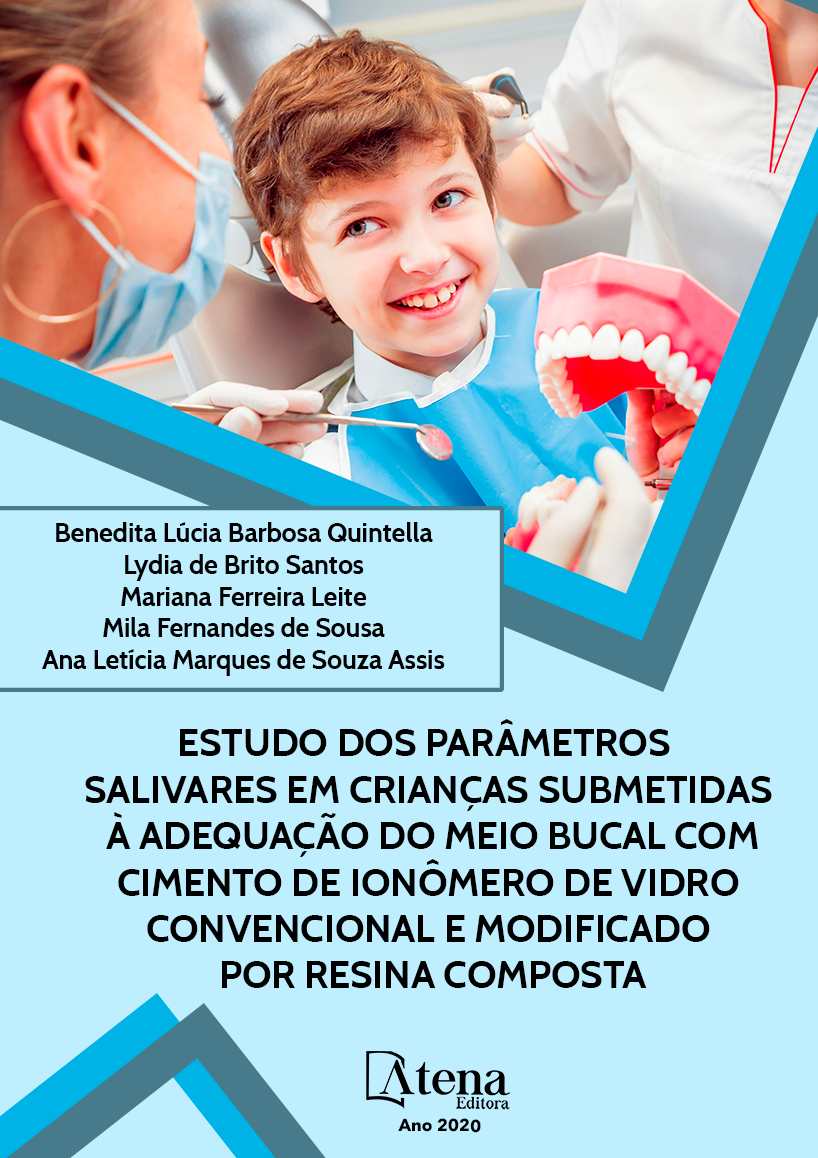
ESTUDO DOS PARÂMETROS SALIVARES EM CRIANÇAS SUBMETIDAS À ADEQUAÇÃO DO MEIO BUCAL COM CIMENTO DE IONÔMERO DE VIDRO CONVENCIONAL E MODIFICADO POR RESINA COMPOSTA
O uso de fluoretos é evidenciado como uma das melhores alternativas contra a doença cárie, havendo diversas formas de utilização destes, entre elas o uso do Cimento de Ionômero de Vidro. O objetivo dessa pesquisa foi avaliar os efeitos do Cimento de ionômero de vidro (CIV) convencional e modificado por resina sobre parâmetros de defesa naturais da saliva de crianças. Um total de 50 crianças, de 6 a 12 anos, com lesões de cárie e/ou necessidade de selamento de lesões de cárie foram submetidas à adequação do meio bucal com CIV Convencional-RIVA self cure-SD (n=25) ou CIV Modificado por Resina-RIVA light cure-SDI. Todas as crianças receberam instrução de higiene oral e creme dental com flúor 1100 ppm. A coleta da saliva ocorreu em três momentos: antes da restauração, uma hora depois do procedimento, 7 (sete) dias após os procedimentos. Foram determinados o fluxo salivar, pH, capacidade tampão total e por faixas de pH, a concentração de cálcio, fosfato e proteína total e a atividade da amilase. Os parâmetros bioquímicos foram comparados por análise de variância (ANOVA) e pós-teste de Tukey de comparações múltiplas. O nível de significância adotado foi de 5% (p <0,05). Foram observados uma redução da concentração de proteína total e fósforo e um aumento da atividade da amilase na saliva uma semana após a adequação do meio com ambos tipos de CIV. Foi observada uma redução da capacidade tampão total e em diferentes faixas de pH após o uso de CIV resinoso. Medidas de adequação do meio bucal com cimento ionômero de vidro alteram positivamente os parâmetros de defesa da saliva, particularmente o convencional.
ESTUDO DOS PARÂMETROS SALIVARES EM CRIANÇAS SUBMETIDAS À ADEQUAÇÃO DO MEIO BUCAL COM CIMENTO DE IONÔMERO DE VIDRO CONVENCIONAL E MODIFICADO POR RESINA COMPOSTA
-
DOI: 10.22533/at.ed.720200104
-
Palavras-chave: Cimento de ionômero de vidro convencional, Parâmetros salivares, Flúor, Fluoretos, Cimento de ionômero de vidro modificado por resina.
-
Keywords: Ionomer cement conventional glass, Salivary parameters, Fluorine, Fluoride, Glass ionomer cement modified by resin.
-
Abstract:
Despite advances in research, the caries still remains as a highly important topic in dentistry, which studies are increasingly researching the mechanisms to prevent it or fight it. The use of fluorides is evidenced as one of the best alternatives against caries, with different ways of using these, including the use of glass ionomer cement, which has been highlighted in recent studies. The objective of this research was to evaluate the effects of conventional glass ionomer cement and resin modified over natural defense parameters of saliva of children. 50 children aged 6 to 12 years with carious lesions and / or need for sealing pits and fissures were submitted to research. The lesions were removed with drills for high, low speed and dentinal curettes; and then restored. And 25 children with cement ionomer Conventional self- RIVA Glass cure-SDI and 25 children with ionomer cement Glass Modified by Resin- RIVA light cure-SDI. All children received instruction in oral hygiene and fluoride toothpaste, Colgate. Saliva collection took place in three stages: The first time was before the restoration, the second moment occurred one hour after the restore procedure, and the third time was 7 days after the procedures. Before the collections, each child was asked to chew Parafilm (paraffin film) for 5 min and spit in a Falcon tube. Obtained 150 samples, it calculated the salivary flow and separated 1 ml for further analysis. The portable digital pH meter was used to calculate the initial Salivary pH and buffer capacity were determined by titration with 0.01N HCl solution. The determination of the peroxidase is made by the method of Anderson (1986) and Chandra (1977), total protein concentration salivary be estimated by the method of Bradford (1976), the amylase activity is determined by the method described by Fisher and Stein (1961). The calcium concentration was determined by the Bioliquid Laborclin kit and phosphate concentration was determined by Phosphor kit Laborlab. The data are presented as mean ± standard deviation (SD), whichever is the Anderson-Darling test for evaluating the frequency distribution of the data. Biochemical parameters of the groups will be compared by analysis of variance (ANOVA) and Tukey’s multiple comparison test. The significance level will be 5% (p<0.05).
-
Número de páginas: 62
- Benedita Lucia Barbosa Quintella
- Lydia de Brito Santos
- Mariana Ferreira Leite
- Mila Fernandes de Souza
- Ana Letícia Marques de Souza Assis
- Benedita Lucia Barbosa Quintella, Lydia de Brito Santos, Mariana Ferreira Leite, Mila Fernandes de Souza, Ana Letícia Marques de Souza Assis


